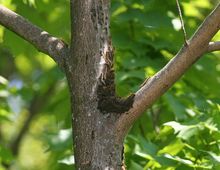Experts report that the Eastern tent caterpillar egg hatch will likely begin in mid-March for Central Kentucky.
“The development of the Eastern tent caterpillar – and insects in general – is directly correlated with air temperature. This helps predict when they will be active,” said Lee Townsend, University of Kentucky College of Agriculture entomologist. “Temperature data from UK’s Ag Weather Center so far shows a pattern in Central Kentucky that is very similar to 2012.”

Eastern tent caterpillars in tree
The Eastern tent caterpillar is important in horse country due to its role in Mare Reproductive Loss Syndrome, which has resulted in staggering losses of foals in recent outbreaks.
© 2013 by Dave Pape
According to Townsend, temperature information can help to predict when eggs will begin to hatch but will give no clue as to how many caterpillars will be present in a given area.
“Last year’s experience is the best thing to go by,” he said. “There has been a gradual but relatively steady general increase in tent caterpillar numbers, and they have become much more apparent in some areas over the past few years.
However, concentrations can be spotty, heavy in some areas and very light in others. The eastern tent caterpillar overwinters in ring-like masses of 100 to over 400 eggs around pencil-sized twigs. A relatively small increase in the number of egg masses from one year to the next can mean a big jump in caterpillar numbers.”
The eastern tent caterpillar is active early each spring. It is an important insect in horse country due to its role in Mare Reproductive Loss Syndrome, which resulted in staggering losses of foals in the 1999-2001outbreak. MRLS can cause late-term foal losses, early- and late-term fetal losses and weak foals.
Subsequent studies by UK researchers revealed that horses will inadvertently eat the caterpillars, and the caterpillar hairs embed into the lining of the alimentary tract. Once that protective barrier is breached, normal alimentary tract bacteria may gain access to and reproduce in sites with reduced immunity, such as the fetus and placenta.
According to Townsend, horse owners with spring-foaling mares should now check their fence lines for wild cherry trees and in a few weeks for signs of tent caterpillar activity.
“This is a good time to prepare,” Townsend said. “Begin by checking pasture fence lines to see how abundant wild cherry is in them. If practical, plan to move pregnant mares from areas where these trees are abundant to minimize the chance of exposure to the caterpillars. The potential is greatest when the mature tent caterpillars leave trees and wander to find places to pupate and transform to the moth stage.”
